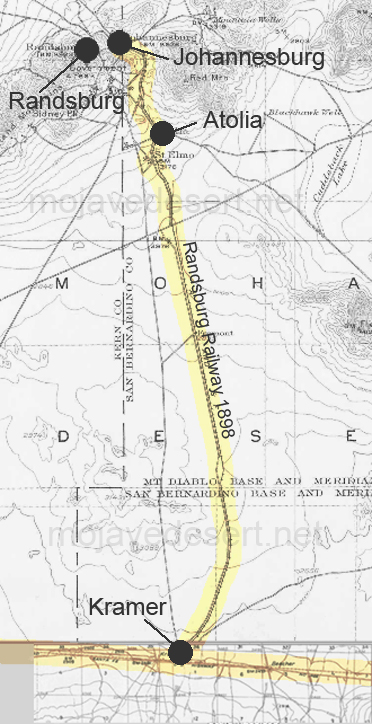The California Rand Silver Mine-Randsburg's Silver Boom
Randsburg's third boom was caused by silver. One of the greatest silver mines in the desert West, the Kelly, or California Rand, was discovered by two men who were out locating red paint. Jack Nosser, an old-time prospector and miner, had some claims near
Atolia
that he felt lacked only development work in order to become paying mines. He offered John Kelly, sheriff of
Kern County,
a share in the claims if Kelly would raise the money needed. Kelly and County Assessor Edith Coons put up the cash. Kelly, Coons, W. H. "Hamp" Williams (a good friend of Kelly) and Nosser formed a partnership.
Development work failed to reveal anything worthwhile, and Miss Coons was beginning to believe she was only throwing her money away. This was her second gamble that hadn't paid off, her first being an unsuccessful stab at relocating the Lost Padre Mine. Kelly, in order to help offset some of the grubstaking expenditures, recalled some red paint pigment claims that were eligible for relocation. He told Nosser and Williams they were on the side of
Red Mountain,
and the two left to relocate the ground in their names. It was hoped the
claims would generate a small amount of quick cash.43
Williams picked up specimens of horn silver on his way back from having located the paint claims, and forwarded the samples to Kelly in
Bakersfield. Within days Kelly was back in
Randsburg
with an assay report that read $60 in gold and 436 ounces of silver per ton. The
specimens were found on idle property owned by the heirs of ore D. J. Mc Cormick. The claim is a few hundred feet from a main road, and
there was a 130-foot shaft on another part of the claim. The operators were looking for gold, not silver. It seems amazing to some that
such a wealthy mine (it later produced more than $13,000,000 worth of ore) was passed right over by two waves of prospectors who combed
the hillsides during the last two rushes. Actually Williams was extremely lucky. The silver veins only appear, due to a fault zone, at
the discovery outcrop, and even that is almost hidden. It is even possible that the outcrop was not exposed at the time the original owners
sunk their shaft.44
Silver has always played a minor role in Randsburg's early mining history. In 1908, the Randsburg District produced $650,000 in gold and
over $5,000 in silver. The silver was entirely a by-product of gold mining. This calculates to a maximum gold fineness of about 750. (The
Yellow Aster bullion averaged about 790 fine) The silver content was nothing to brag about. It lowered the value and purity of the gold
bullion and would have been considered to be a poor reflection of the gold camp's richness. Although silver was present here and noticed
from the beginning, no major attempt to discover silver was made at Randsburg because no large silver vein was ever suspected in this gold
district. Now, all of this changed abruptly.
Kelly, Williams, Nosser, and Coons immediately secured an option on the McCormick property for $5,000 and claimed all the adjacent land they could. Miss Coons and Kelly disposed of a small portion of their individual one-fourth shares in the mine for $50,000. The mining world sat up and took a heavy interest. Was it only a rich surface deposit or a second Comstock? 45
Circumstances heavily favored the partners. No development work was needed to get at the ore; they just scooped it out. After two months $1,770,000 worth of ore had been extracted and the mine was still just a hole 50 feet deep, with no waste dump. With a
railroad
in the front yard and the Pittman Act pegging silver at one dollar an ounce, the California Rand Silver Mine certainly was found at the right time and in exactly the right place, enabling its owners to make millions.
With the discovery of silver,
Randsburg
went wild for the third time. The towns of Osdick and Hampton were born in the summer of 1919. The post office came to Osdick on February 14, 1922. The production of the California Rand Silver Mine from June I, 1919, to August 1, 1923, was over $7,000,000. In 14 months from 1921 through February; 1922, one claim (the Grady Lease) produced 18,245 tons of ore valued at $1,613,074! Silver mines and prospects popped up along a 2 mile by 1 1/4 mile area. Shafts were dug south and north of the Kelly in hopes of meeting the extension of the high-grade mineralization. Most failed, except the Coyote on the southeast edge of the Kelly and the Santa Fe on the northeast edge.46
In June 1923, with the provisions of the Pittman Act fulfilled, silver prices dropped to 65 cents per ounce. However, by careful management and increased production, the California Rand was able to continue mining silver profitably. By 1926 the mine had a total gross production of over $13,000,000 with dividends totaling $4,500,000. In 1929 the mine could not be operated profitably, and it was sold to Henry W. Klipstein of the H. W. Gould Company for $50,000. In the fall of that same year, the post office at Osdick changed its name to
Red Mountain. 47
